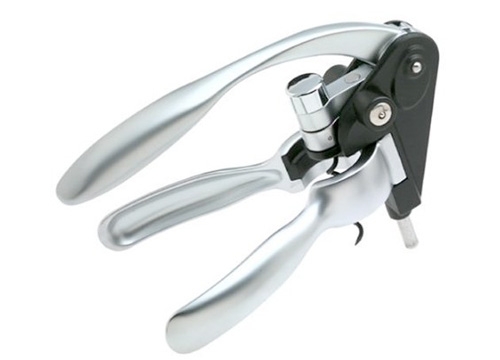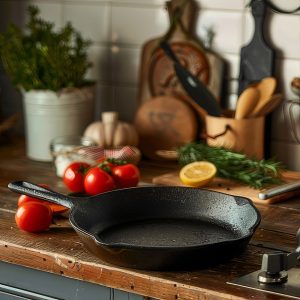A Good Corkscrew Is Important In Every Kitchen!
A good corkscrew is essential in your kitchen, especially if you enjoy wine with your meals.
Corkscrews let you open bottles of wine, champagne, and other corked beverages. For centuries, they are also called bottle or wine openers. A typical corkscrew includes three main parts: a helix, a handle, and a lever arm.
A metal spiral helix twists into the cork to grip and remove it. You hold the handle while turning the helix. Handles made from wood, plastic, or metal, provide a comfortable grip.
The lever arm, a more recent addition, offers extra leverage for easier cork removal. It rests on the bottle’s top and helps push the helix into the cork while pulling it out.
Corkscrews come in many designs, each with unique features. Popular options include the waiter’s corkscrew, winged corkscrew, electric corkscrew, and rabbit corkscrew.
Wine professionals prefer the waiter’s corkscrew for its small, compact design and ease of use. The winged corkscrew, with two levers, offers extra leverage for simpler cork removal.
Electric corkscrews use a motor to twist the helix into the cork. They work quickly, require minimal effort, and are great for convenience. The rabbit corkscrew relies on a lever arm to insert and remove the cork, making it a popular choice for those who find traditional designs challenging.
Who Invented the Corkscrew?
Corkscrews trace their origins to ancient Greece, where people used a tool called the “triglyph” to remove corks from amphorae, large clay jars used to store wine. However, the modern corkscrew was invented in the late 18th century.
The invention of the corkscrew remains debated. Reverend Samuel Henshall of Oxford, England, patented his design in 1795, featuring a helix and a T-shaped handle for leverage. Around the same time, Englishman Edward Thomason created a similar design.
In France, Reverend Canon Jean-Baptiste Croizet also invented a similar corkscrew in Burgundy.
In 1802, German inventor Karl Wienke improved the design by adding a wire helix and a button to eject the cork. His invention, called the “screw-pull,” became popular in Europe and laid the foundation for many modern corkscrews.
Since then, corkscrews have evolved with features like levers and gears to make cork removal easier. Today, they come in various shapes, sizes, and materials, making them essential tools for wine lovers and professionals alike.

What is the most popular used corkscrew today?
It’s difficult to pinpoint the most popular corkscrew, as people’s preferences vary based on their needs. However, a few corkscrew designs stand out for their ease of use and effectiveness.
The waiter’s corkscrew remains a favorite among wine professionals and enthusiasts. Its compact size and versatility make it a top choice. This design typically includes a helix, a folding knife blade for cutting foil, and a double hinge for extra leverage when pulling out the cork. Its small size makes it easy to carry in a pocket or apron, which is why restaurant servers love it.
The winged corkscrew, also called the butterfly corkscrew, is common in many households. It features two metal wings that lift up to extract the cork. These wings provide extra leverage, making cork removal easier. Affordable and easy to use, the winged corkscrew is a popular option for casual wine drinkers.
Another popular choice is the lever corkscrew, or rabbit corkscrew. This design uses a lever arm to insert and remove the cork. The added leverage makes cork removal easier and requires less effort than traditional corkscrews. The rabbit corkscrew is a great option for those who struggle with classic designs.
Electric corkscrews have gained popularity for their convenience. These tools use a motor to twist the helix into the cork, making the process quick and effortless.
Various Types
Many corkscrews are available, each with unique features. Here are some of the most popular types:
Waiter’s Corkscrew: This compact design, often used by wine professionals, includes a helix, a folding knife blade for cutting foil, and a double hinge for extra leverage when pulling the cork out. Small, easy to use, and favored by restaurant servers, it’s a top choice for many.
Winged Corkscrew: Known as the butterfly corkscrew, this design features two metal wings that lift up to extract the cork. Easy to use, affordable, and common in households, it’s a go-to option for many wine drinkers.
Lever Corkscrew: Also called the rabbit corkscrew, this design uses a lever arm to remove corks. It requires less effort and is easier to use, making it ideal for those who find traditional corkscrews challenging.
Electric Corkscrew: This modern option uses a motor to twist the helix into the cork. Quick, efficient, and requiring minimal effort, it’s perfect for anyone needing to open wine bottles quickly.
Twist Corkscrew: This simple design features a helix and handle. A traditional option that is easy to use and affordable, it’s perfect for those who prefer the classic method.
Ah-So Corkscrew: This design, also known as the two-pronged corkscrew, doesn’t require a helix. Instead, two prongs insert into the sides of the cork, allowing it to be removed without damage. It’s ideal for old or fragile corks.
T-Handle Corkscrew: This traditional design has a T-shaped handle. Sturdy, simple, and easy to use, it’s often available at an affordable price.
Table-Mounted Corkscrew: This larger, industrial design mounts on a table or counter. It uses a lever arm to insert and remove the cork, providing extra leverage. It’s common in wineries and wine-related businesses.
Twist and Pull Corkscrew: This unique design combines the twisting motion of a traditional corkscrew with the pulling motion of a lever corkscrew. It’s perfect for those who want extra leverage while using a traditional method.
Gas-Powered Corkscrew: This modern design uses gas pressure to remove the cork. Fast and easy, it requires no physical effort, making it ideal for people with limited strength or mobility.
Magnetic Corkscrew: This innovative design uses a magnet to pull the cork out of the bottle. The helix has a magnetic tip that attaches to the cork, removing it without damage. It’s perfect for those who want to avoid damaging the cork or wine.
What is a Foil Cutter and How is It Used?
A foil cutter is a small tool designed to cut and remove the foil or seal covering the top of a wine bottle. You use it with a corkscrew to prepare the bottle for opening.
A foil cutter typically features a circular, serrated blade that fits over the bottle’s top and cuts through the foil or seal. Some foil cutters are handheld, while others integrate into corkscrews or wine openers.
To use a foil cutter, place it over the top of the wine bottle and rotate it around the bottle’s circumference. This action makes a clean cut through the foil or seal. Afterward, you can remove the foil by hand or with pliers.
Using a foil cutter makes opening a bottle of wine easier and more efficient. It ensures a clean cut, preventing small pieces of foil from falling into the wine or getting stuck in the corkscrew. It also adds a professional touch to the process, making it a must-have tool for wine enthusiasts and professionals alike.
Do Corkscrews Have Foil Cutters Attached to Them?
Yes, many corkscrews come with foil cutters attached. This feature eliminates the need for a separate tool, allowing you to prepare the wine bottle for opening with just one device.
Corkscrews that include built-in foil cutters include waiter’s corkscrews, winged corkscrews, and lever corkscrews. In most cases, the foil cutter is integrated into the handle or body of the corkscrew, making it easy to access.
To use a corkscrew with a built-in foil cutter, locate the cutter on the device and position it over the top of the wine bottle. Apply gentle pressure as you rotate it around the bottle’s circumference to cut through the foil. Once you’ve removed the foil, use the corkscrew to open the bottle.
A corkscrew with a built-in foil cutter is a great choice for those who want to streamline the wine-opening process. It’s especially useful for those who frequently open wine bottles and prefer an easy-to-use and store all-in-one tool.
What is the most expensive?
Several corkscrews are among the most expensive in the world. One of the most famous is the 18th-century silver-plated corkscrew made by London silversmith Hester Bateman. Collectors highly seek this corkscrew, and it has sold at auction for over $20,000.
Another notable expensive corkscrew is the Laguiole collector’s corkscrew, handmade by French artisans using traditional techniques and high-quality materials. These corkscrews often feature decorations made from precious metals and gemstones, costing several thousand dollars each.
In addition, several contemporary corkscrews designed by famous designers and luxury brands are priced at thousands of dollars. For example, the German brand L’Atelier du Vin produces a limited edition corkscrew set called “Coffret Collector Oeno Box,” which includes a range of wine accessories and is priced at over $4,000.
Five Fun Facts About Corkscrews
- The corkscrew was not the first tool invented for removing corks from wine bottles. Before corkscrews became popular in the 18th century, people used various other tools, including hammers, knives, and even hot tongs to extract corks.
- The world’s largest corkscrew collection belongs to Don Bull, who has over 14,000 corkscrews in his collection. The Guinness World Records has recognized his collection as the largest.
- In the early 20th century, some corkscrews were designed to also function as weapons. These “multi-purpose” corkscrews had sharp blades or pointed ends for self-defense.
- The earliest corkscrews did not have a helix or spiral-shaped screw. Instead, they had a pointed tip that was pushed into the cork and then twisted to extract it from the bottle.
- The corkscrew has been the subject of many patents over the years. The first corkscrew patent was granted in England in 1795, and since then, inventors have filed thousands of patents for various designs and features.















